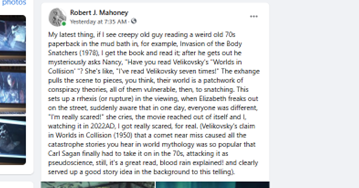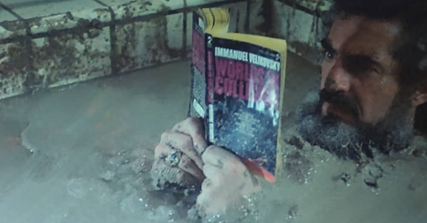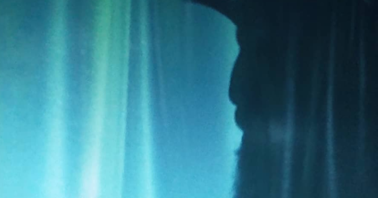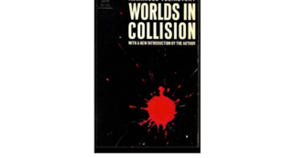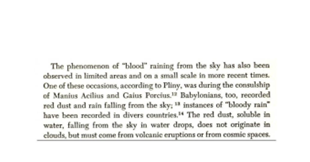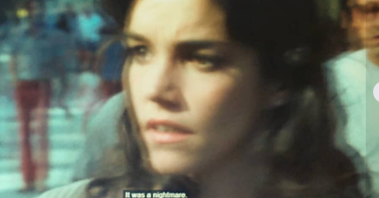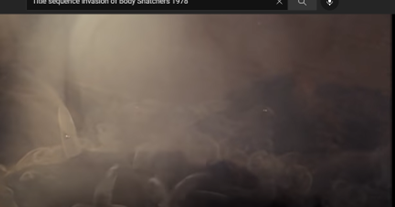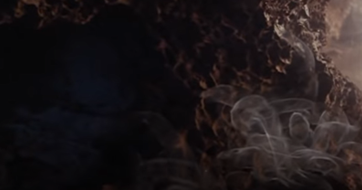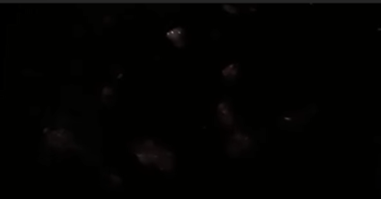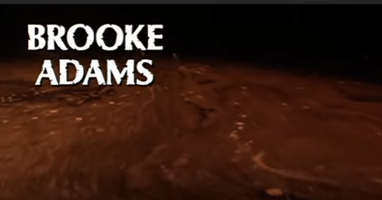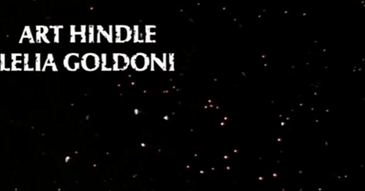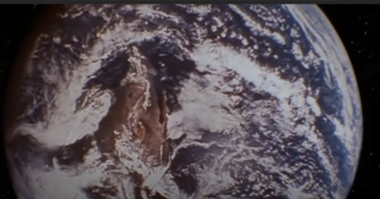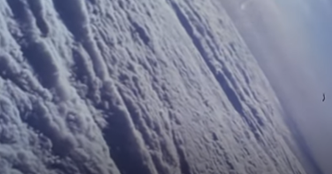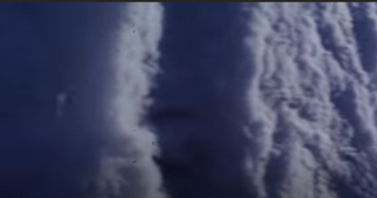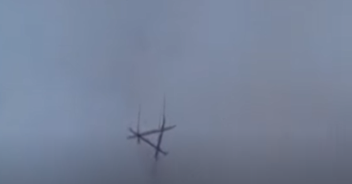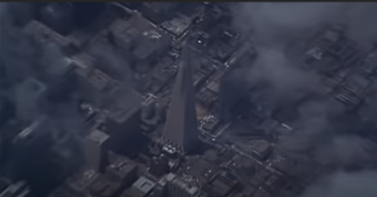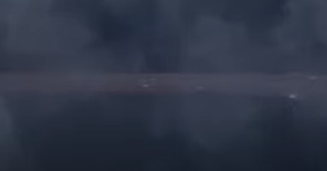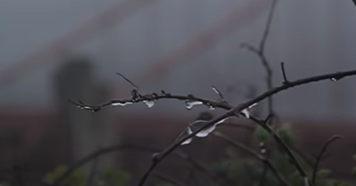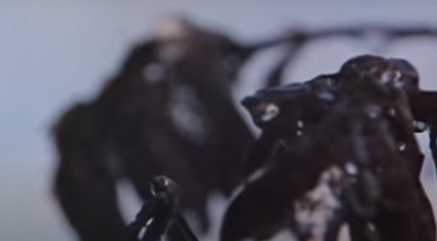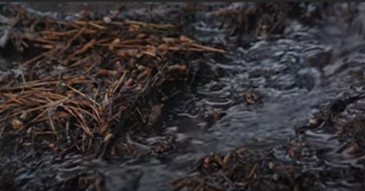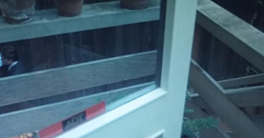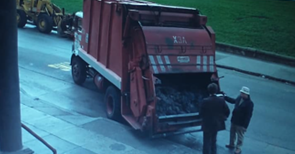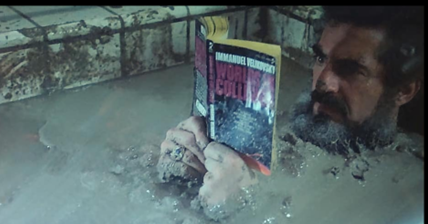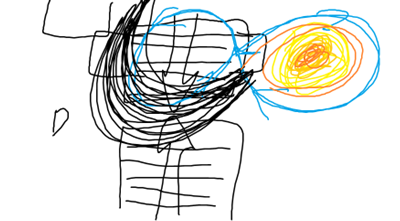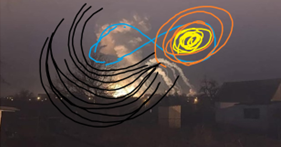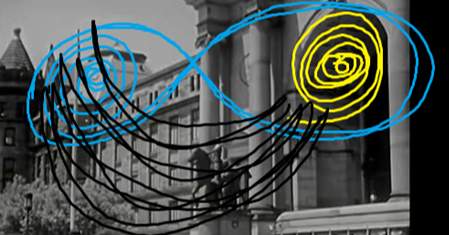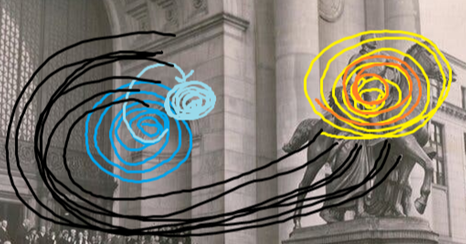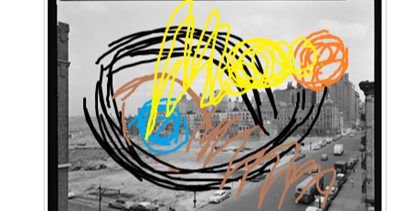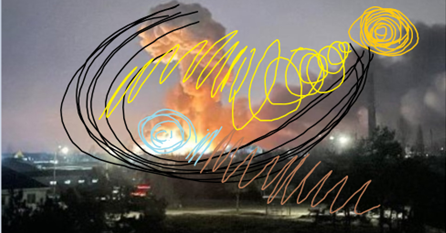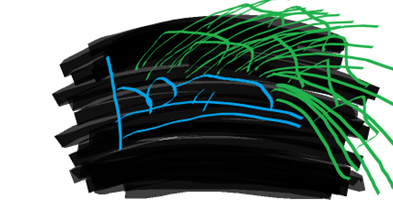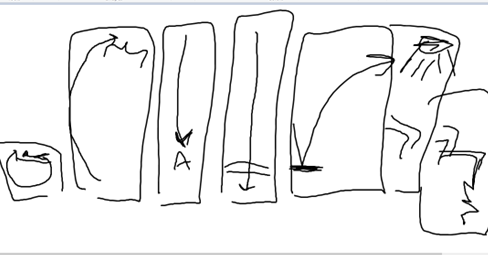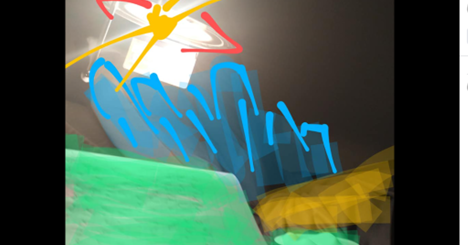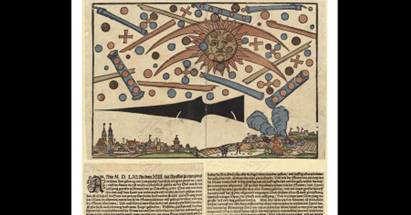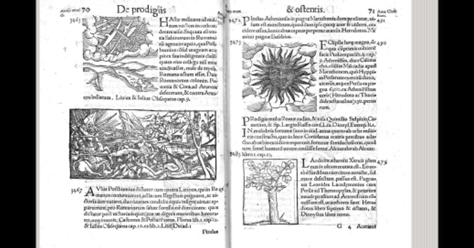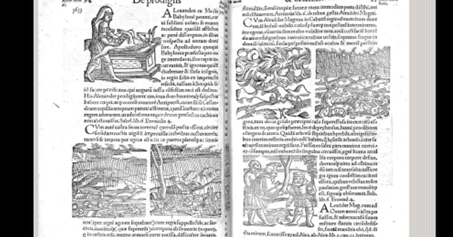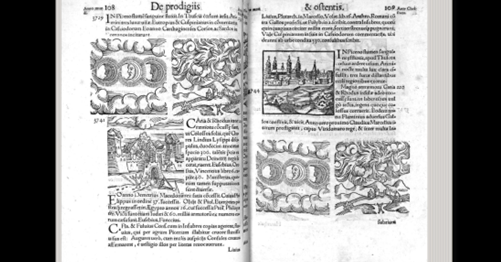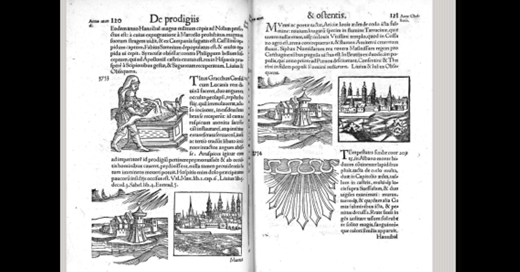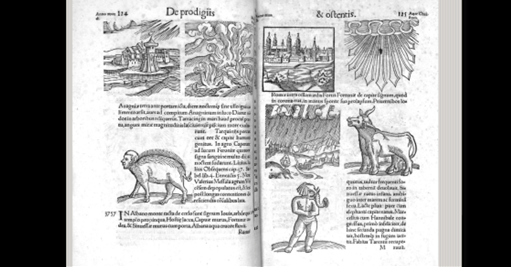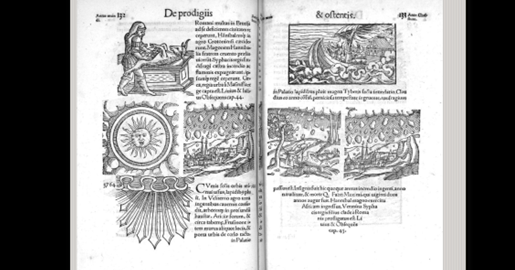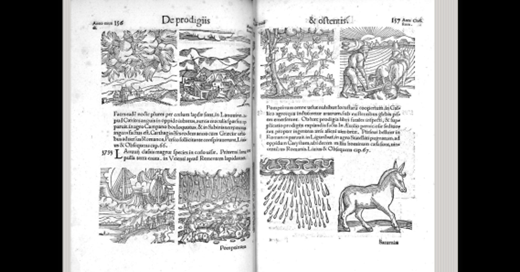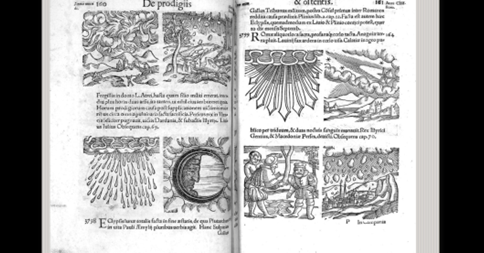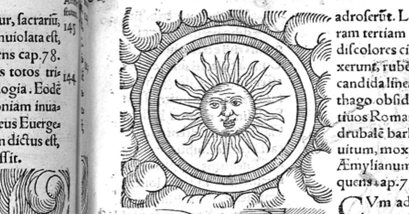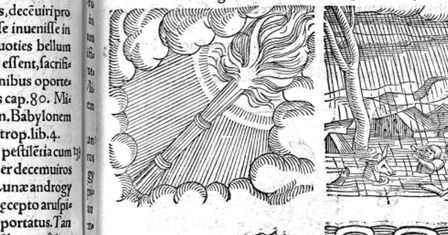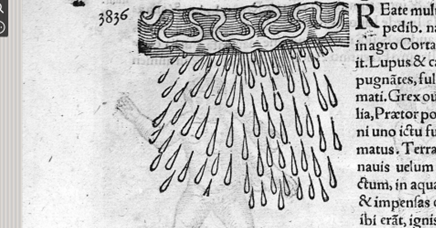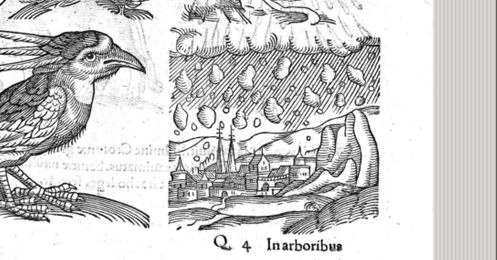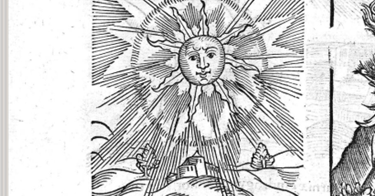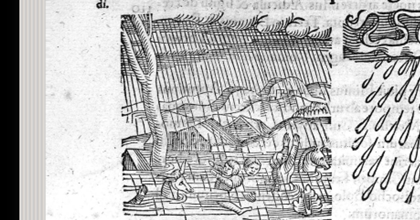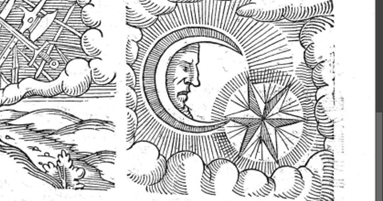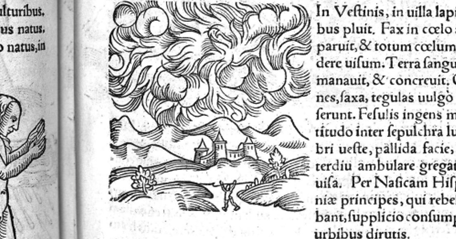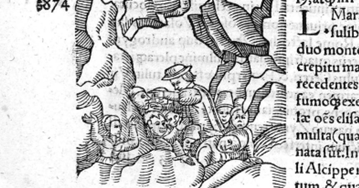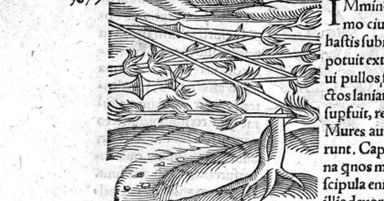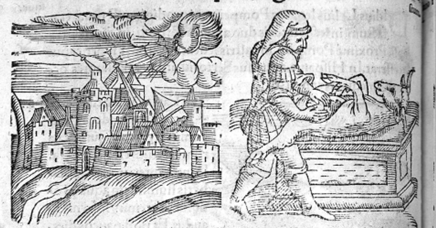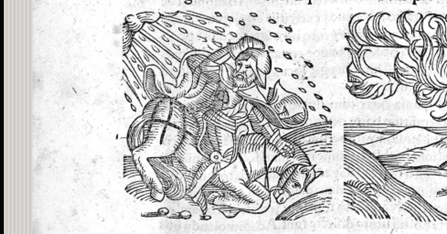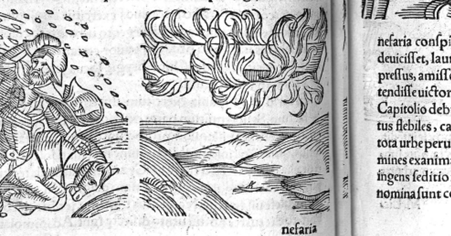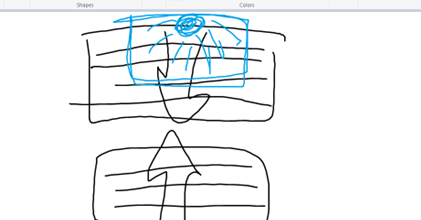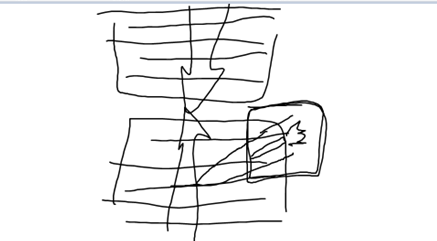Rev., Feb 15-16, 23-24, 2022.
Velikovsky continues, “the swift shifting of the atmosphere under the impact of the gaseous parts of the comet, the drift of air attracted by the body of the comet, and the rush of the atmosphere resulting from inertia when the earth stopped rotation or shifted its poles, all contributed to produce hurricanes…of a worldwide dimension” 87 The dark figure who brought this was called Hurakan, from which “hurricane” derives, a darkness swept by wind, Hurakan killed “a major part of the human race”: 87 A hurricane was called a diluvium venti by the Romans, a deluge of wind. 88 The red sea is also called the shari, or the sea of percussion, mare percussionis, because of the strike and disaster 89
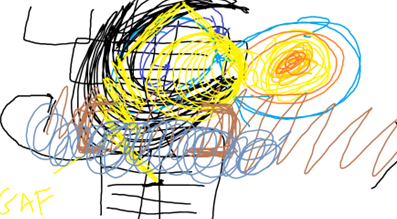
Then, in fact, this happened because “the slowing down or stasis of the earth in its rotation would cause a tidal recession of waters, toward the poles, but the celestial body near by would disturb the poleward recession, drawing the water toward itself” 91, thus causing high waves to crash over all. Even the Choctaw have a legend of mountain-high waves rapidly coming nearer, and they are in Oklahoma 91. Thus the “seas heaped up in immense tides” caused a “pageant” to go on in the sky, “which presented itself to the horrified onlookers on earth as a gigantic battle” 96

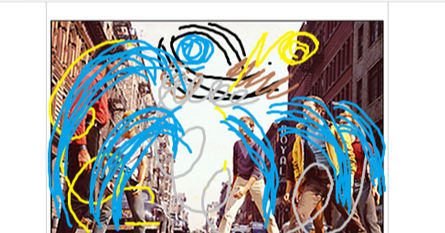
The Battle of the Waves, Velikovsky 1940 2 23 22
Again, as to the bright day, this happened because the pass of the comet distorted the orbit of the earth, thus, “emerging from the darkness, the Eastern hemisphere faced the head of the comet. This head only shortly before had passed close to the sun and was in a state of incandescence, thus the night was as bright as the day of the summer solstice”. 97 Also, “the tail of the comet and its head, having become entangled with each other by their close contact with the earth, exchanged violent discharges of electricity” “it looked like a battle between the brilliant globe and the dark column of smoke”. “In the exchange of the electrical potentials, the tail and the head were attracted one to the other and repelled from one to the other, from the serpentlike tail extensions flew” 97 “It looked now like a furious animal with legs and many heads”. 97 Thus, “the events in the sky were viewed by the peoples of the world as a fight between an evil monster in the form of a serpent and the light-god who engaged the monster in battle and thus saved the world”. 98 This in the description of typhon as having hands that extend from horizon to horizon, a hundred dragons head, a body all winged, fiery eyes, hurling rocks, and hissing and shouting, 99 Needless to say, all this interests me, as Velikovsky is having sky visions which I have traced from Nuremberg on.
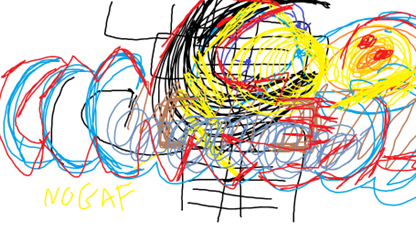
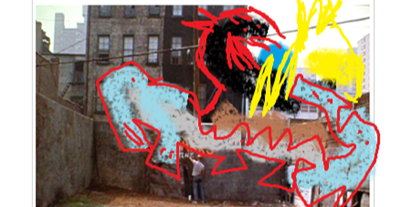
fire serpent velikovsky 1940 2 23 22
Indeed, at one point, he mentions Rockenbach, who wrote De cometic tractatus novus methodicus in 1602, he found a copy in the US, he synchronized the battle of Typhon with the Hebrew Exodus.The same argument was made by Samuel Bochart in Hierozoicon, another 17th cent book (on internet archive but in unreadable German original copy). For him the flight of Typhon is the exodus of Moses from Egypt.105 Another element is that the sky collapsed, and this was caused by a rain of meteorites and fire from the sky, this too a universal legend 109. Then when the two celestial bodies were driven near each other, :the interior of the globe pushed toward the exterior, disturbing the rotation, causing heat, and this melted the land and boiled the oceans” 111. The Talmud then describes a curious incident, regarding the Mountain of the Lawgiving, which appeared to lift up and shake over the heads of the people. As a result, the people “felt as if they were no longer standing securely on the ground, but were held up by some invisible force (this sounds like my dizziness)”, “the presence of a heavenly body over head caused this phenomenon and this feeling (this a hover dream)”. 115
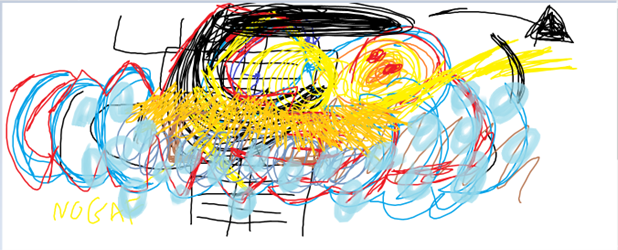
Then too the earthquakes resulted in roaring noise from the earth, earthquakes were preceded by a terrible sound

Sinai Floats over the People Velikovsky 1940 2 23 22
“the earth heaved deep sighs, “the sun was attributed to the gods and called theophany (this sentient, and ambient, horror based) 116. At Sinai the trumpet sounded long, the sound was read by Moses as “I am that I am”, and says exodus, “all the people saw the roars, and the torches, and the noise of the trumpet, they trembled, and stood far off” 117 (tremble). Says Velikovsky, the approach of two charged globes toward each other could also produce trumpetlike sounds 117. The thunderings and lightnings, as described in Exodus, the names are KOLO and LAPIDUM (two more demons) 117. Velikovsky also seems to claim that the ten commandments were sonic pareidols heard sounding in the sky, so “Lo Tirzah” thou shalt not kill, and Lo tinaf thou shalt not commit adultery, this was heard’ by all the inhabitants of the earth 118. Even more extreme, Velikovsky claims that this disturbance caused the earth to flip from east to west and up and down, (the flip dream construct), soon “the side which is now turned toward the evening once faced the morning” 125/ Ipuwer says the land turned round as does a potters wheel, the earth turned upside down, This caused terrible devastation 127.
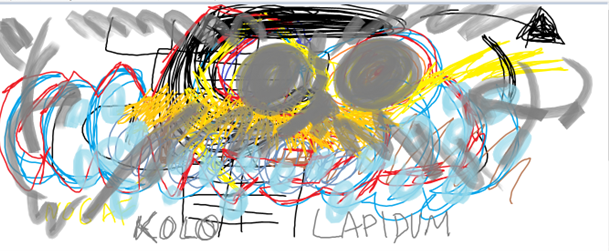

Kolo and Lapidum velikovsky 1940 2 23 22

the trumpets of kolo and lapidum reversed the earth’s east to west. Velikovsky 1940 2 23 22
“Harakhte” embodied this, it means “he riseth in the west, 128. This is proven by the magnetization of some rocks, polarized oppositely from the prevailing present direction 135. Pliny describes the gloomy year after Caesars death, a whole year of continuous gloom, Virgil says, the sun veiled his shining face in dusky gloom, and a godless age feared everlasting night. Germany heard the clash of arms through all the sky (again, the battle in the sky), the Alps rocked with unwonted terror, and specters, pale and wondrous-wise, were seen at evening twilight 146. The gloom in the year after Caesar was once again caused by the dust of the comet dispersed in the atmosphere., The “clash of arms” heard through all the sky was probably the sound that accompanied the entrances of the gases and dust into the earth’s atmosphere 147. This same process drew blood to the skin and made Ethiopians black 164.

Then Velikovsky focuses on Venus and Mars, the feast of their convergence involved a day of atonement, in which a goat was sent as scapegoat into the desert, to Azazel, the fallen star of lucifer, typhon Seth, Uzza thrown into the Red Sea allowed the passage, 176. This is related because the morning star is the star that first appeared after the convulsions and this was Venus, It looked like a serpent, called Gukumatz or Kukulcan, the Mexican name representing the catastrophe 177. It seems Venus changed its nature then too, taken as a prodigy 178. The golden calf was the image of the star, the bull, the star that attacks the planets. 186 When Athene Tritogeneia, or third born, was born, the sky wailed 185. This happened on March 19, in Exodus this was the 13th day after the vernal equinox, the night of the great shock 192. An offshoot of this was when manna fell into the rivers, turning them to milk, thus the bull worship became cow worship 201. As for Venus’s path, “Venus sprang out of Jupiter as a comet and flew very close to the earth, it became entangled in the embrace of the earth, the heat cased the vermin of the earth to propagate at a feverish state, the plagues of gods and locusts must be ascribed to such causes”, 204. The multitude of flies was under the aegis of Beelzebub, Ball Zevov, Ares the fly god too, 205
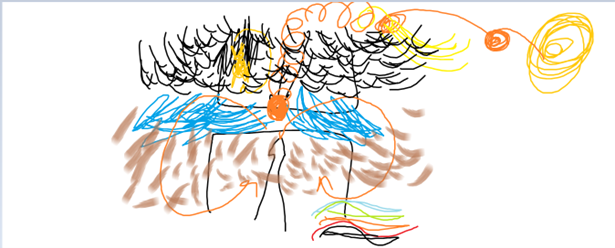
Gukumatz and the rain of larvae in Mexico velikovksy 1940 2 12 22
In Mexico, Sahagun reports people thought comet tails shot darts that caused larvae to form on things, corrupting them, for that they closed their chimneys and apertures against the morning star to prevent the mishap from penetrating into the house together with the light. 206. The Egyptians, however, thought that the flies in the tail of Venus were “not merely the earthly brood, swarming in heat like other vermin, BUT GUESTS FROM ANOTHER PLANET”. In this context, Velikovsky writes MODERN BIOLOGISTS TOY WITH THE IDEA THAT MICROORGANISMS ARRIVE ON THE EARTH FROM INTERSTELLAR SPACES, CARRIED BY THE PRESSURE OF LIGHT. Hence, the idea of the arrival of living ORGANISMS FROM INTERPLANETARY SPACES IS NOT NEW. WHETHER THERE IS TRUTH TO THIS SUPPOSITION OF LARVAL CONTAMIATION OF THE EARTH IS ANYONE’S GUESS. THE ABILITY OF MANY SMALL INSECTS AND THEIR LARVAE TO ENDURE GREAT COLD AND HEAT AND TO LIVE IN AN ATMOSPHEREE OF OXYGENE RENDERS NOT ENTIRELY IMPROBABLY THE HYPOTHESIS (and also Jupiter, from which Venus sprang, may be populated by vermin 207.) THIS…is the smoking gun, likely the source for the idea underlying the formulation of the story in Invasion (1978)

Jupiter and the Body Snatchers from space thesis velikovsky 1940 2 23 22
All of these notes, made on the 23rd, then bounced off works of art by Robert Nava, which I saw later in the day and posted on.

Robert Nava, of the moment…or minute, Night Gallery, his latest effort really hit the synchroetherhhoe* spot with me because I am still reading Immanuel Velikovsky’s catastrophist visions of ancient history, used as source for the Invasion of the Body Snatchers (1978), it was odd to me that he said he figured it all out after he escaped from Europe to New York in 1940, I figured (imaginatively) that he was having Gerard Nerval type panic attacks, underscoring his crazy idea that the people of Israel during Exodus witnessed a comet clashing with the earth’s atmosphere causing a hurricane in the sky to look like a great battle between a lightning god and a gigantic many-headed red dragon, and then when the comet’s head hit the already debris-strewn black cloud of the sky over Sinai the mountain of the law lifted up by volcanic eruption created an earthcrackup noise heard as celestial trumpets so loud they reversed the earth on its axis, east to west, caused the Israelites to feel tossed up into the air and the earth to boil and melt below them (precisely a stage three dizzy attack), the trumpets of doom, the mountain become sound, called in the bible Kolo and Lapidum. I made a graph of this nightmare structure, and scirpographs, over scenes of New York, Fire Serpent, and Kolo and Lapidum, Velikovsky 1940. Which look pretty close, though graphs, to Nava, so, he has catastrophist imagination, which is a thing, and his push-pull is actually quite psychodynamically true. *my word, everything all at once flowing together, it can also be catastrophic.
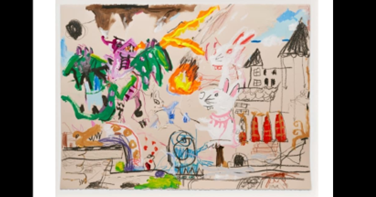
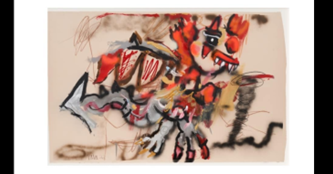
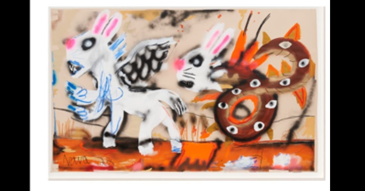
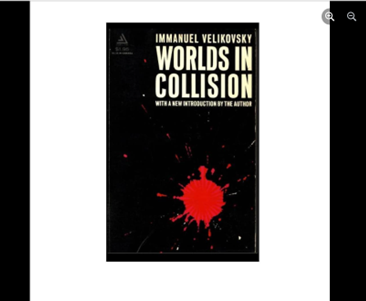

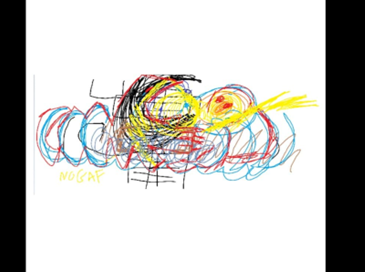

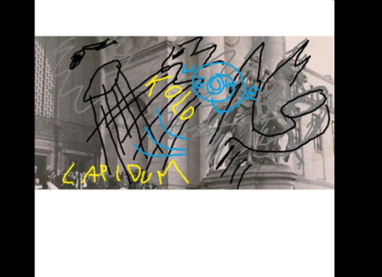
Velikovsky goes on, The Skidi Pawnee of Nebraska, in particular, believe that the world is endangered by the Venus 211. This is the story of the sacrifice of al virgin to the morning star in March, her body painted to look like the star, red, in a black skirt, hair and face painted red, he describes the whole thing, with a source, 212. “At the appearance of the morning star the girl’s heart was ripped out, the sacrifice smeared himself with blood, everyone shot arrows at her, then fire from bundle laid to the directions lit” 213. In Velikovsky’s history Venus was a comet that became a planet. Even Isaiah railed against it, “o lucifer, son of the morning” 222. According to Velikovsky, Venus was born as a comet in 2000 bc, in 1000 bc it twice made contact with earth, which changed its orbit. In the 800s bc there was still another comet, that caused further changes 223. Then came a commotion, celebrated on February 26 747 229, Isiah foresaw the destruction, if not for a small portion left, we would’ve been like Sodom and Gommorah 230. Everyone retreated into caves, 231 “What aileth thee now, that thou art wholly gone up to the housetops?: 232 This was the shaog, or earth shock, the field of action which is the entire world versus a localized earthquake, a shaking of the earth brings a shaking of the sky with it, 233. “Fear, and the pit, and the snare are upon thee, O inhabitants of the earth”, 233. It is here that Velikovsky defends his reading by arguing that it has been lost because rationalists make metaphors out of everything, 239, which is a critique I practice, 239. Then too Nebuchadnezzar, “I will shake the heavens and the earth shall remove out of her place, in the wrath of the lord of hosts, and in the day of his fierce anger” 240. Velikovsky comments “In a settled world nothing altered the given order. To sustain this doctrine, the prophecies were translated into metaphors, Maimonides said the prophets would never predict the upsetting of nature” 241.
Further on, Velikovsky carries his determinism even further. Describing a rite of the Aztecs, where a priest shot an arrow into the effigy of Huitzilopochtli, which penetrated the god, who was then considered dead,” Velikovsky argues that “this appears to have been a symbolic repetition of the electrical discharge that Venus ejected towards Mars”. 272 In India, there was many terms for planetary junctions, conjunctions, unitings, unions and encounters, and when they battled, the force of the planet or its battle won or lost. 274 He also argues that Huitzi was a shape shifter in imitation of the act that the atmosphere of the planet Mars was distorted by its approaches to other celestial bodies and “took on different shapes:” 282 In Rome, the reason Romulus ended up in legend being cared for by wolves is that the planet Mars was occasionally shrouded in a wolflike way, this is also suggested by the fact that in story Romulus was born in the middle of a total eclipse 282. It was also due to the trembling earth, the displacement of the poles, the change of the climate, the frightening prodigies in the sky, that the Aztecs were told by huitzi to move, so they carried their idol with them searching for a new home, and thereafter “asserted that this idol commanded them to land in their country” 287. Pliny also wrote about the planetary discharge, “heavenly fire spit forth by the planet as crackling charcoal flies from a burning lo.” 290. Mars-Nergal was, moreover, the one with the power to move the earth off its hingers, the earth, says Isiah, removed out of its place, 292. (This reminds me again that in extremis of schizo Nerval had a vision of the earth knocked out of its orbit, right outside the Louvre). Velikovsky also writes recurrent displacement of the terrestrial globe, torsion of the lithosphere, and migration of the inner parts of the globe must have caused a succession of earthquakes, 292. Again, in terms of mythology, “when Mars was very close to the earth, its two Trabants, a word for satellite, were visible. They rushed in front of and around Mars, in the disturbance that took place, they probably snatched some of Mars’ atmosphere…and appeared as gleaming manes.” This emerged in mythology as Mars’ steeds when he was descending to earth to punish people. Velikovsky even is amused that Asaph Hall, in naming the satellites of Mars, without realizing the connection to the myth and to the fact of the displacement, named them Phobos (terror) and Deimos (rout) 298, Venus also was said to have hair because, transitioning from a comet, it still had a tail. Thus, when it clashed with Mars, asteroids and meteorites were torn from this trailing part, and began a semi-independent existence. These swarms of meteorites with their gaseous appendages were newborn comets, which closely followed Mars like a troop following its leader 299. These became in myth the terrible ones, the furies. Velikovsky again describes the hallucination, “The comets looked like revolving torches or writhing snakes, they assumed the form of spinning wheels and the celestial phantasmagoria appeared like swift chariots, changing their forms, the Maruts looks like horses racing along the sky and then again like a host of warriors, leaping, climbing, irresistible” 301. The spectators saw the celestial prodigies either as demons, as the Erinyes of the Greeks or the Furies of the Latins, or executors of the lord’s wrath, as in Joel and Isaiah, 304. The stone of Cronus at Delphi, the image of Diana at Ephesus, the stones of Amon and Seth at Thebes, the palladium of Troy, all were meteorites that fell from the sky. 307. The stone on which the temple of Solomon was built, Eben shetiya, the fire stone, was a bolide that fell in the beginning of the tenth century, in the time of David, when a comet, which bore the appearance of a man with a sword was seen in the sky. The sacred shield of Numa at Rome, the ancile of Roman Mars, was also a bolide, it fell from the sk, 208. Comets seen on the screen of the sky also were seen to look like witches on brooms all over the world. 323. Velikovsky also argues that the myths of Venus and Mars come from people seeing the play of Mars and Venus in the sky. He compares it to sex, “interplanetary contacts in the celestial sphere are in some respects similar to congress and germination in the biological worlds. In these contacts the bodies of the planets overflow with lava, fertile ground for vegetation, and comets born of such contacts fly across the solar system and rain as stones and possibly also spores, germs or larvae on planets. (here again, the invasion scenario)” 379.
One finds in Velikovsky, then, the continuation to 1940 in New York of a visionary culture stretching back to German Renaissance prints where celestial events were likewise interpreted as religious miracle events. Velikovsky places ancient texts in the position of prototype, and forces the solar system to conform to it. This results in a highly impossible conception of space, and it is surprising that anyone felt it necessary to refute. It is especially interesting to find both blood rain, a battle in the sky, and the casting or tilting of the earth out of orbit, tropes of visions going back to Nuremberg 1561, but forward to Nerval, in my studies of it, all have origins in the bible, and then Velikovsky literalizes them for the 20th century. My theory is that all are psychodynamic, and can be graphed out.
Thus, in placing Velikovsky’s Worlds in Collision (1950) in the movie, both visually, and mentioned, the movie momentarily retrogresses to a prototype state in which the spores coming to earth seemed possible. All horror movies have this “if this is true, then anything can be true” moment, it is the forward part of the to be continued trope, it unsettles one into the foo space, and lets then the movie proceed with its horror. But, again, as I noted, I felt this in the sequence, the Velikovsky seemed to pull apart the coherent sense of place and time and render the mis en scene as porous and psallictive, allowing of any unbelievable thing. The lore also ensconces the descent of the invasion in the context of comet or meteoric sky sights, and thus Elizabeth’s freak out in downtown that suddenly everything seems different, this is yet another iteration of a kind of vision I have traced back by way of Nerval to Glasner in 1561 Nuremburg. The sudden change of consciousness of so much of the public is another catastrophist horror on par with those mentioned above. The fact that the new tower built in San Francisco at the time, the Transameria pyramid, then only one year old, was in this case read as a kind of UFO bringing the spores to earth, the representative, then, of an encounter of the third kind, whereas the movie itself is indirectly about an encounter of the fifth kind, but transferred to the home court of the victims.
But, again, once again, a 70s movie is pulled apart and some of it given to the honeycomb in a bottled up, unspoken unconscious space prototypical to it, and thus this subrosaplot wiggles through things. The fact that Nimoy is a book author reinforces as well the idea that in the 70s foo culture, tabloid culture, penumbra cultures, all this was conveyed, as I have taken note, by means of mass market paperbacks with deadpan captions and limited but authoritative pictures.
Then, things get strange. As Nancy is taking care of the older fat man, the one reading Velikovsky gets dressed and is leaving but we see him move as if a shadow behind the veil of the green curtains between tables or bathings, and in this capacity he more or less represents Acoupane, a forecaster of trouble coming from deeper in the universe.

I looked at this title, no vibe yet
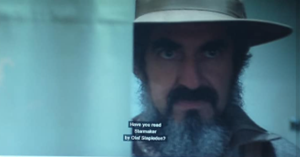

As this is a dream figure, his presence in this role bespeaks that this strange site is sunk in hypnagogy, represented by the mud.
Then, for some reason, he takes up a position in one of the cubicles, and when Nancy opens the curtain to find him, he asks her, almost as if a test or a prophecy, have you read Starmaker by Olaf Stapledon? and, then, have you reading Worlds in Collision by Velikovksy?
And perhaps Nancy knows his game and suspects he is once again trying to mystify her, so she shoots back, I’ve read Velikovsky many times, meaning that she is a total counterculture hippie but now set loose in her own world in the 70s.; Nancy is partially hidden when asked, she is kind of stunned he is there, but answers.
Right after this happened, seeing Jeff Goldblum somehow patronizing the place, I had an odd thought.
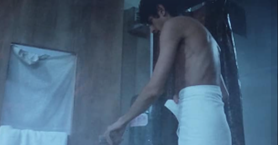
Another person whose personal belief system is not aligned with reality, but filled with weird ideas from pseudoscience, but, apparently still, at the time, still believed in as truth. The bottom dropped out, and the whole scene, and it is possible I felt something that taught me of the origins of the oft-mentioned pulled-apart nature of movies in the 70s, they were pulled apart because the sense of reality had splintered into various cults, and, in the 70s, nothing was adding up.
At this point, the movie goes over the top in making use of this mis en trope as a talus in the manner of a reverie field of bedsheets, as we now movie cautiously through the green veils (and they would be evocative of entoptic sightings), there is a hissing.
Then Nancy comes in on another client, and says, “Oh Jack, you’re going to suffocate”, because he is covered up completely, over the head
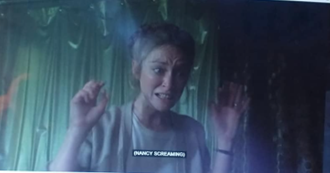
Perhaps, it could be argued, this is a bit quick to spill all the beans, and tell us the whole mechanism by which the aliens are snatching bodies up. Now Goldblum and Sutherland come in and they do all the study of it, appalled


But as a construct, it fits entirely in the mis en trope of a public bath that gives green mud baths and bodies are covered and uncovered in strange ways. It is all but a figure of the place, green, check, vague, check, covered in gunk, check, and, then, even, unformed, chck, being then a figure of the way in which Nancy and all engage with reality, and then even childlike, so that too. It is all but emblematic of the 70s, where just as shadows were taller than our souls, bodies were pulled out of themselves, to, in emergency, undertake strange adventures, unreal, and in the leap from 60s activism to 70s idealism a number did not make the jump and crashed and burned, thus a time of carnage due to the influence of cult ideas too.
Then the fact that we see a shot of Jeff Goldblum lying down, to prepare for a massage, or maybe a bit more of after hours with his wife, so a whisper of kinkiness in a crawlspace is suggested for the place too; and, then, unbeknownst to him, it is lying a few stalls down, this suggests, one on one, a peculiar masquerade, which I have not overly outlined as yet. I have noticed that lattice level dreams are simply narrow projections of what is going on in the body of the sleeper, translated into the imagery of a dream. This like all dream elements can take a very close to the body and far from the body look. A body that is quite heavy with no lift can likely dream its own pain, where some demon is literally a figure of a pain in the side. This arrangement suggests a deeper level of the Empty Pillow syndrome, akin to the Death Mask, but full body. Again, a Death Mask is when you wake up (but not) and see your face gazing at you from the other pillow, a mirror effect. Now it is posited that there is a redoubt just below that where one’s sleeping body can dream one’s body next to it and in some way alter or tailor that body to wake up as someone else. And if this process is coopted by a superior force then that function can be used to make your sleep create yourself in facsimilia but this time one taken over by them, and one of them, foreign to you. This is not a hover dream, but a side by side dream, working on the trope of a transplant or transformation surgery, like in Frankenstein. It suggests that if a tingle captures the whole of you in sleep it can then as if by a mirror create a dream body that is improved upon one, and thus you wake up with it. But again, here, the process is reversed, and by the use of a pod with a magic power given it by the spores, this model unformed sucks form from one to create a facsimile of one, that then to take over, that is, it to wake up, your old self to collapse into an empty skin (an idea I saw echoed in Antlers this week where the Wendigo possesses the subject to such an extent that his face is left hanging disembodied out front as a veil disembodied. Also, in Paranormal activity: Next of Kin, Margot searches for secrets in an attic room, then has to hide in a bed; when a weight settles in on it, to press her down, she has to look, and sees, I think, only a black wig, this, with the tin and the doll would be, see my treatment in The Man Who Haunted Himself) a pegma. This body magic might relate to bed spells that seek to return lost loved ones to one’s bed (see the 1930s former slave tapes).
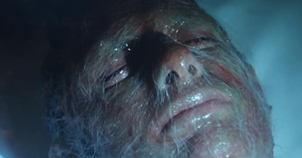
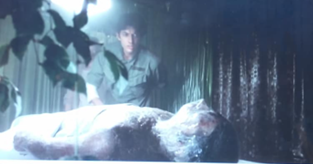
Indeed, in its negative, horror sense, I just encountered a version of this. In Privilege (2022, Germany) it turns out that Finn is an orphan twin, taken in by his parents precisely because of no relation, with no family connection, and it seems that him being the child of low class people was taken as a good thing, again breaking ties, for then older members of the cult to dance in his skin when they age out. I compare this to the Alraune mythos, wherein a girl is born of a magic plant with formal humanoid properties, but vegetable, and since the child of a murderer or worse, she grows up empty and evil. This scenario of podding is also of a vegetable character, thus bespeaking a possession. For now, I will call this area the Alraune trope masquerade.
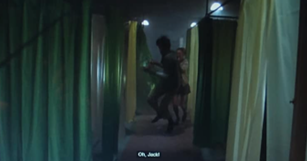
But, then, while Goldblum was able to wake up, and thus pull back from it, Matthew realizes immediately that Elizabeth must be in trouble, because she fell asleep, so he calls her, we already see a lesion of cave-in in her face. While Goldblum and Nancy thus run away from the pod that is trying to take over him, he runs back to Elizabeth’s house to then come up through the back window of the basement in a corkscrew around pod Geoffrey’s inattention to rescue her.
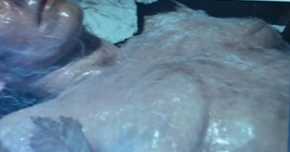

By the time he gets up to her he sees her copy growing in the greenhouse nearby and she is fairly well developed, except that her boobs remain a bit flat and have no nipples yet, but just in time. The whole body looks gelatinous and greasy, gross, not a trace of sexuality.

Then, when later challenged, I forget the sequencing, we are given an alibi formation, we see a mound of dirt, two upturned basic pots are meant to be what he thought were her breasts, and then another kind of pre-Columbian pot up top is meant to be a face, and the overall purpose of this masquerade alibi form is so that nonbelievers can say, see, this is what you saw, I can see where you might think for a moment, in panic, that that was a body.
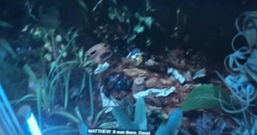
(as in so many of the sequences in the movie, haunted by its classic prototype, the 1956 version, this telling is all but a remake of the episode by which he goes to the house, then finds a lookalike pod in a freezer or store cabinet in the basement. Then, when talked out of it, he is shown the alibi formation. Again, in this case, an alibi formation is like an Alraune in form but different in that it is an assemblage of objects meant to look like the original. These forms of masquerade I will borrow from the above, and call Trabants.
All of this gets a bit too busy for me, with the police called, etc, here is an odd energy in the tiny room they argue in, Nimoy is aloof, suggesting that he has been taken over,

Geoffrey we know is taken over and a blank face, he seems profiled by an odd blank face picture, bespeaking the obtuseness of his presence,
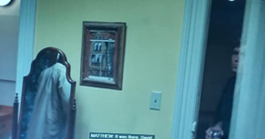
(this is a classic Trabant formation aka alibi formation but in reverse, it exposes Geoffrey as not him by disembodying him with the double of a mirror, therefore, a blank space, within (and in the original at one point the pod form was called a blank), and then the through-the-window peeping, which shows that no one is home. This is a Trabant picture)
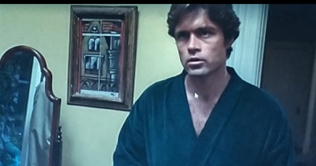
Then it is in this context that Nancy gets to let loose with her hippie talk, and she believes that what has happened is a kind of poisoning which is reenacting the creation of the human race out of apes by aliens eons ago, this is a new phase. She seems to believe that the human race was created by aliens mating with apes (so on par with Kubrick).

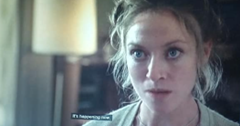
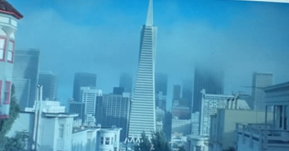

Then, after this, another walkabout, by Sutherland, and then he gets a direct attack, and we see fully the pod process, and, after a long run around, neither of them get out, the end. (at some future date I will fill in with part 3, on the Velikovskyian elements of the movie, which go completely over the top with a catastrophist vision of the USA in 1976).
